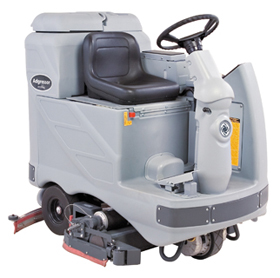
Advance is one of the world’s leading manufacturers of high-quality commercial and industrial floor cleaning and maintenance equipment. Advance is committed to developing versatile equipment that supports both environmentally-friendly cleaning and facility cleanliness. Advance is a brand of Nilfisk-Advance, Inc.
Monday, January 30, 2012
CRI Testing Program – Water Containment
Last week’s blog post discussed machine certification for soil removal. This week, we will analyze the CRI testing program in terms of water containment.
Since moisture residue in carpet can cause any number of problems from mold to fostering bacteria growth, it is important that no excess water remain after the extractor finishes extracting an area. In this CRI test, a cut pile of carpet is weighed to determine its “dry” weight. The carpet sample is then given a set quantity of water. The extractor is allowed four passes over the sample to remove as much water as possible. After the extractor has finished, the carpet sample is weighed again to determine how much water remains. To receive certification, the machine can leave no more than eight ounces of water behind per square yard of carpet.
Stay tuned next week for the last component in the CRI testing program: carpet appearance retention.
Monday, January 23, 2012
CRI Testing Program - Soil Removal
Last week we discussed what CRI certification really means for carpet extractors. Over the next few weeks, we will analyze the three different areas that the CRI testing program certifies machine performance in. These include soil removal, water containment and carpet appearance retention.
The combination of foot traffic and dust settlement can lead to a large amount of soil buildup in carpet, requiring the need for soil removal. CRI’s soil removal test utilizes X-ray fluorescence (XRF) technology developed by NASA that analyzes the emission spectrum when an atom is excited. In the test, a patch of carpet receives a set amount of soil. The cleaning machine is then allowed to extract the carpet. After the machine is done cleaning, the XRF gun irradiates the carpet, and the soil left behind emits fluorescent X-ray radiation based on the energy characteristics of each element. Scientists then measure the intensities of the emitted energies to determine how much soil remains in the sample. If the extractor is able to remove 55-70 percent of the soil it receives bronze certification, 70-80 percent earns silver distinction and by removing 80 or more percent of the soil the extractor is rated with a gold certification for soil removal.
Check back next week for a discussion on the CRI testing program for water containment.
Monday, January 16, 2012
CRI Carpet Extractor Certification
When evaluating carpet extractors, cleaning professionals want equipment that gets the maximum soil out of the carpet and leaves the carpet as dry as possible. While manufacturers claim their products are efficient or effective, it can be difficult to validate these claims. However, that’s starting to change. The Carpet and Rug Institute (CRI), in conjunction with NASA, has a testing program that rates extractors for their ability to remove soil and water as well as their ability to preserve carpet appearance. An extractor with the CRI Seal of Approval means the extractor meets the highest standards in the industry for efficient and effective cleaning, as well as appearance retention. CRI’s scientific testing procedure provides the hard data you need to evaluate and compare carpet extractors.
A CRI Seal of Approval on an extractor tells purchasers that the machine meets specific standards for operation and performance. Equipment manufacturers voluntarily submit their extractor models for the Carpet and Rug Institute’s independent testing. An independent board of scientists reviews the test results and recommends whether to certify the machine.
Stay tuned for next week when we discuss machine performance certification in different areas.
Monday, January 9, 2012
Seeing the Spectrum™ 12H in Action
Designed to withstand the grueling environment and unique operational needs found in the hospitality market, the Spectrum™ 12H Upright Vacuum delivers exceptional cleaning performance and superior filtration. You will notice the difference, and so will your guests.
- Industry-leading design delivers exceptional dirt pick up and edge cleaning, allowing for one pass cleaning and greater staff productivity.
- High efficiency, three-stage H.E.P.A. filtration system improves indoor air quality for operator and guest comfort.
- Comfortable, quick-draw wand and onboard tools simplify detailing work.
- Lightweight, ergonomic design for greater operator comfort.
- Meets LEED requirements with CRI Seal of Approval and low sound level.
Tuesday, January 3, 2012
Warehouse Cleaning
Warehouse cleaning applications can present unique cleaning challenges due to their generally large sizes and, at times, the material or goods that are stocked in them.
Mitsubishi Electronic Power Products, located in Warrendale, PA, manufactures high-voltage circuit breakers for the utility industry. Prior to shipping products to utility customers, the parts for these circuit breakers are stored in a new 40,000-sq. ft. warehouse facility about four miles from the manufacturing site. To control dust, dirt and sand from constant forklift traffic, prevent product contamination and keep floors clean and attractive for visitors, Mitsubishi initially used a walk-behind scrubber, which took a significant amount of time and labor. For higher productivity and to cut cleaning time, they implemented the Advance Adgressor®.
The Adgressor® is a reliable industrial rider scrubber that is easy to use and maintain. Delivering high productivity, the Adgressor offers large scrub decks and solution capacities, in addition to easy maneuverability and high speed. Plus, equipped with the optional EcoFlex™ System, operators can clean their floors more efficiently and create a more sustainable cleaning program.
For more information on this case study and to read other case studies, visit: http://www.advance-us.com/solutions/casestudies.aspx.
Subscribe to:
Posts (Atom)

